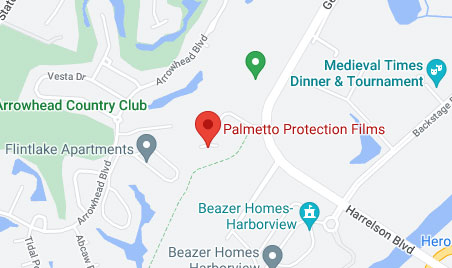COMMERCIAL WINDOW FILM
We provide commercial window film protection for all types of office, retail, restaurant, and industrial spaces.
If your employees or customers are uncomfortable with the sun’s bright glare or its radiant heat, give us a call for a no-obligation consultation. We have a solution for the problem.
Energy Conservation
Up to 30% of any building’s cooling and heating load is through windows. Installing window film reduces the stress on a facility’s HVAC system. Many films block up to 80 percent of the sun’s heat, helping to cut cooling costs.
Safety and Security
Windows and doors are the most vulnerable parts of any building. They are easy points of entry for people who may mean harm to the occupants, the building itself, or its contents. When professionally installed safety film is added, the glass doesn’t shatter, delaying the intruder’s entrance, and allowing local authorities to get to the scene in a timely matter.
Green Benefits
Nearly 75% of windows are not energy efficient, according to the Environmental Protection Agency. Window film installation costs a fraction of new window replacement, and accomplishes many of the same goals, as well as going a long way in reducing a building’s carbon footprint.
Health and Comfort
The Skin Cancer Foundation recommends solar control window film to protect healthy skin and prevent premature aging. Window film lets natural daylight in, but blocks up to 99% of the sun’s damaging ultraviolet rays, and up to 80% of the sun’s heat protecting the building’s occupants and preventing interior furnishings from fading. Employees are also more productive and comfortable thanks to window film reducing solar glare, not only on their computer screens but throughout the entire building.
Aesthetics
Window film can improve the aesthetics of any commercial building. By improving the look of dated windows with film, the whole building will appear as though it had a modern facelift. Many manufacturers also offer decorative films that can add style, privacy and create a unique interior design. With certain styles of decorative films, facility executives can even achieve the look of etched glass at a fraction of the cost.
COMMERCIAL WINDOW FILM GALLERY
LIFETIME WINDOW TINT PROTECTION GUARANTEE
Palmetto Protection Films offers a lifetime guarantee against bubbling, peeling, discoloring, or delaminating. We’ll replace the film at no cost to you.
*Lifetime Window Tint Protection Guarantee applies to the original owner when service was completed and is non-transferrable.
There's No Such Thing as the Perfect Tint Job...
All window tint is carefully applied, but due to static & floating particles, a job will never be 100% particle free or perfect. Read more from the International Window Film Association:
Architectural Visual Inspection Standard For Applied Window Film
1. Installed film on flat glass surfaces is not expected to have the same level of visual quality as glass. The following criteria apply to the installed film only and not to any defect inherent in the glass.
2. Installed film has a discrete time for full adhesion to be effected since installation utilizes a detergent solution in the water to float the film onto the glass: the excess water is squeegeed out, but inevitably residual water will remain between the film and glass. The time to achieve full adhesion is often referred to as “the adhesive cure time”. Adhesion will be increasing from a lower value during this time. Visual and adhesive cure time is related to thickness of the film and various metallic coating on the film. Typical visual cure times may be extended or shortened according to climatic conditions.
3. Inspection for optical quality can be made before full visual cure is attained. Table 1 provides a guide for typical visual cure times. It should be noted that effects during cure, such as water bubbles, water distortion, and water haze are not to be regarded as defects.
4. The glass with applied film shall be viewed at right angles to the glass from the room side, at a distance of not less than 6 feet (2 meters). Viewing shall be carried out in natural daylight, not in direct sunlight, and shall assess the normal vision area with the exception of a 2 inch (50mm) wide band around the perimeter of the unit.
5. The installation shall be deemed acceptable if all of the following are unobtrusive (effects during visual cure should be disregarded): Dirt Particles, Hair and Fibers, Adhesive Gels, Fingerprints, Air Bubbles, Water Haze, Scores and Scratches, Film Distortion, Creases, Edge Lift, Nicks and Tears. Inspection may by made within 1 day of installation. Obtrusiveness of blemishes shall be judged by looking through the film installation under lighting conditions described in 4.
6. The 2 inch (50mm) wide band around the perimeter shall be assessed by a similar procedure to that in 3 and 4, but a small number of particles is considered acceptable where poor frame condition mitigates against the high quality standards normally achieved.
7. Edge gaps will normally be 1/32 – 1/16 inch (1-4mm). This allows for the water used in the installation to be squeegeed out. This ensures that film edges are not raised up by contact with the frame margin. Contact with the frame margin could lead to peeling of the film.
8. For thicker safety films the edge gaps will normally be 1/32 – 1/16 inch (1-4mm), with 1/32 – 1/8 inch (1-5mm) being acceptable for films of (7 mil (175)). Combination solar control safety films will also fall within this standard. An edge gap of up to 1/16 inch (2mm) is recommended, especially for darker (tinted, metallized, tinted/metallized, and sputtered) films, to minimize the light line around the edge of the installed film.
9. Splicing of films is necessary when larger panels of glass are treated, where both length and width of the glass exceed the maximum width of film. The splice line itself should not be viewed as a defect. This line should be straight and should be parallel to one edge of the frame margin. The two pieces of film may be butt jointed. The maximum gap at any point in the splice line should be 1/64 inch (1mm). Film may be overlapped, spliced or butt jointed.
10. Certain films with special high performance coating may have lengthened cure times. Consult the manufacturer for cure times of these films.
Table 1 – Typical Cure Times
Film thickness in mils Film thickness in microns(µ) Typical Cure Time (days)
Up to 4 Up to 100 30
4 to 8 100 to 200 60
8 to 12 200 to 300 90
Over 12 but not more than 17 Over 300 but not more than 425 140
*Special adaptation of information received from the Glass and Glazing Federation; reproduced with their permission.
Copyright© International Window Film Association | All Rights Reserved
Architectural Visual Inspection Standard For Applied Window Film
1. Installed film on flat glass surfaces is not expected to have the same level of visual quality as glass. The following criteria apply to the installed film only and not to any defect inherent in the glass.
2. Installed film has a discrete time for full adhesion to be effected since installation utilizes a detergent solution in the water to float the film onto the glass: the excess water is squeegeed out, but inevitably residual water will remain between the film and glass. The time to achieve full adhesion is often referred to as “the adhesive cure time”. Adhesion will be increasing from a lower value during this time. Visual and adhesive cure time is related to thickness of the film and various metallic coating on the film. Typical visual cure times may be extended or shortened according to climatic conditions.
3. Inspection for optical quality can be made before full visual cure is attained. Table 1 provides a guide for typical visual cure times. It should be noted that effects during cure, such as water bubbles, water distortion, and water haze are not to be regarded as defects.
4. The glass with applied film shall be viewed at right angles to the glass from the room side, at a distance of not less than 6 feet (2 meters). Viewing shall be carried out in natural daylight, not in direct sunlight, and shall assess the normal vision area with the exception of a 2 inch (50mm) wide band around the perimeter of the unit.
5. The installation shall be deemed acceptable if all of the following are unobtrusive (effects during visual cure should be disregarded): Dirt Particles, Hair and Fibers, Adhesive Gels, Fingerprints, Air Bubbles, Water Haze, Scores and Scratches, Film Distortion, Creases, Edge Lift, Nicks and Tears. Inspection may by made within 1 day of installation. Obtrusiveness of blemishes shall be judged by looking through the film installation under lighting conditions described in 4.
6. The 2 inch (50mm) wide band around the perimeter shall be assessed by a similar procedure to that in 3 and 4, but a small number of particles is considered acceptable where poor frame condition mitigates against the high quality standards normally achieved.
7. Edge gaps will normally be 1/32 – 1/16 inch (1-4mm). This allows for the water used in the installation to be squeegeed out. This ensures that film edges are not raised up by contact with the frame margin. Contact with the frame margin could lead to peeling of the film.
8. For thicker safety films the edge gaps will normally be 1/32 – 1/16 inch (1-4mm), with 1/32 – 1/8 inch (1-5mm) being acceptable for films of (7 mil (175)). Combination solar control safety films will also fall within this standard. An edge gap of up to 1/16 inch (2mm) is recommended, especially for darker (tinted, metallized, tinted/metallized, and sputtered) films, to minimize the light line around the edge of the installed film.
9. Splicing of films is necessary when larger panels of glass are treated, where both length and width of the glass exceed the maximum width of film. The splice line itself should not be viewed as a defect. This line should be straight and should be parallel to one edge of the frame margin. The two pieces of film may be butt jointed. The maximum gap at any point in the splice line should be 1/64 inch (1mm). Film may be overlapped, spliced or butt jointed.
10. Certain films with special high performance coating may have lengthened cure times. Consult the manufacturer for cure times of these films.
Table 1 – Typical Cure Times
Film thickness in mils Film thickness in microns(µ) Typical Cure Time (days)
Up to 4 Up to 100 30
4 to 8 100 to 200 60
8 to 12 200 to 300 90
Over 12 but not more than 17 Over 300 but not more than 425 140
*Special adaptation of information received from the Glass and Glazing Federation; reproduced with their permission.
Copyright© International Window Film Association | All Rights Reserved
WHAT FOLKS ARE SAYING ABOUT OUR COMMERCIAL WINDOW FILM PROTECTION
“We had security film installed. We found this company at a home show and I’m glad we did. Everyone that was involved including the owners and installers were professional, pleasant and personable. We picked the clear film and it doesn’t look like anything is on the windows, looks great. They have different tints to pick from. We would definitely recommend this company.”
“They did a great job installing frost to give our employees some privacy. They also striped off old tint and installed new tint on our front doors. The new tint is keeping the heat low in our lobby. Will definitely hire for future projects!”
“I used Palmetto Protection Films to tint the windows at my salon and I absolutely love them. Everyone was friendly and efficient! Great business!!! I highly recommend them!”

